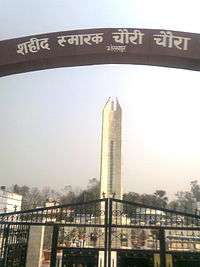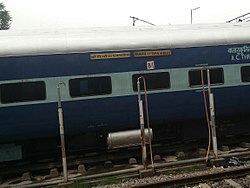Chauri Chaura incident
The Chauri Chaura incident took place at Chauri Chaura in the Gorakhpur district of the United Province, (modern Uttar Pradesh) in British India on 4 February 1922, when a large group of protesters, participating in the Non-cooperation movement, clashed with police, who opened fire. In retaliation the demonstrators attacked and set fire to a police station, killing all of its occupants. The incident led to the deaths of three civilians and 22 policemen. Mahatma Gandhi, who was strictly against violence, halted the non-co-operation movement on the national level on 12 February 1922, as a direct result of this incident.[1]

Background
In the early 1920s, Indians, led by Mahatma Gandhi, were engaged in a nationwide non-cooperation movement. Using non-violent methods of civil disobedience known as Satyagraha protests were organised by the Indian National Congress to challenge oppressive government regulatory measures such as the Rowlatt Act, with the ultimate goal of swaraj or independence.
The incident
Two days before the incident, on 2 February 1922, volunteers participating in the Non-co-operation Movement led by a retired Army soldier named Bhagwan Ahir, protested against high food prices and liquor sale in the marketplace. The demonstrators were beaten back by the local police. Several of the leaders were arrested and put in the lock-up at the Chauri Chaura police station. In response to this, a protest against the police was called on 4 February, to be held at the local marketplace.[2]
On 4 February, approximately 2,000 to 2,500 protesters assembled and began marching towards the market at Chauri Chaura. They had gathered to picket a liquor shop in the market place. Their leader was arrested, beaten and put in jail. Part of the crowd gathered in front of the local police station shouting slogans demanding the release of their leader. Armed police were dispatched to control the situation while the crowd marched towards the market and started shouting anti-government slogans. In an attempt to frighten and disperse the crowd, the police fired warning shots into the air. This only agitated the crowd who began to throw stones at the police.[3][4][5]
With the situation getting out of control, the Indian sub-inspector in charge ordered the police to open fire on the advancing crowd, killing three and wounding several others. Reports vary on the reason for the police retreat, with some suggesting that the constables ran out of ammunition while others claimed that the crowd's unexpectedly assertive reaction to the gunfire was the cause. In the ensuing chaos, the heavily outnumbered police fell back to the shelter of the police chowki while the angry mob advanced. Infuriated by the gunfire into their ranks, the crowd set the chowki ablaze, killing all of the Indian policemen and chaprassis (official messengers) trapped inside.[3][4][5] Most were burned to death though several appear to have been killed by the crowd at the entrance to the chowki and their bodies thrown back into the fire. The death count is reported variously in the literature as 22 or 23 policemen killed, possibly due to the subsequent death of an additional burn victim.[3][4][5]
Aftermath
In response to the killing of the police, British authorities declared martial law in and around Chauri Chaura. Several raids were conducted and hundreds of people were arrested.
Appalled at the outrage, Gandhi went on a five-day fast as penance for what he perceived as his culpability in the bloodshed.[4] In reflection, Gandhi felt that he had acted too hastily in encouraging people to revolt against the British Raj without sufficiently emphasising the importance of ahinsa (non-violence) and without adequately training the people to exercise restraint in the face of attack. He decided that the Indian people were ill-prepared and not yet ready to do what was needed to achieve independence. Gandhi was also arrested and sentenced to six years of imprisonment but was later released in February 1924, on grounds of his ill health.[5]
On 12 February 1922, the Indian National Congress halted the Non-co-operation Movement on the national level as a direct result of the Chauri Chaura tragedy.[6]
Nehru and most of the workers of the Congress, who were in prison when Gandhi took this decision, felt that this was a hasty and incorrect decision at a time when the nation was finally uniting and rising up to the might of the British government in India. A few months after this withdrawal, the government arrested Gandhi and put him in jail.[7]
Trial and conviction
A total of 228 people were brought to trial on charges of "rioting and arson" in conjunction with the Chauri Chaura affair.[8] Of these 6 died while in police custody, while 172 were sentenced to death by hanging following conviction in a trial which lasted eight months.[8]
A storm of protest erupted over the verdicts, which were characterised as "legalised murder" by Indian Communist leader M.N. Roy,[8] who called for a general strike of Indian workers.[9]
On 20 April 1923, the Allahabad High Court reviewed the death verdicts; 19 death sentences were confirmed and 110 were sentenced to prison for life, with the rest sentenced to long terms of imprisonment.[10]
Memorial
- A memorial to the dead policemen was dedicated by the British authorities in 1923.[11] Following Independence the words Jai Hind[1] were added to it, as well as a verse by poet Jagdamba Prasad Mishra which is made famous by revolutionary poet Ram Prasad Bismil. The verse reads: Shaheedon ki chitaaon par lagenge har baras mele ("On the pyres of martyrs, there will be fairs every year").[12]
- The people of the district did not forget the 19 persons tried and executed after the Chauri Chaura incident . In 1971, they formed an association called – Chauri Chaura Shaheed Smarak Samiti. In 1973, this Samiti constructed near the lake at Chauri Chaura a 12.2 meters high triangular minaret on each side of which a figure is depicted hanging with a noose round his neck. The minaret was built at a cost of Rs 13,500 contributed by popular subscription.[11][1][12]
- Later another Shaheed Smarak (now the main one) was built by the Government of India to honour those hanged after the incident. This tall memorial has names of those executed engraved upon it.[13] A library & museum related to the independence struggle has been set up near the memorial.
- Indian Railways have named a train to honour those executed after the Chauri Chaura incident. The train is named Chauri Chaura Express, which runs from Gorakhpur to Kanpur.

References
- "Haunted by memories". India Today newspaper. 20 October 2003. Retrieved 5 January 2017.
- Event, Metaphor, Memory – Chauri Chaura 1922–92 by Shahid Amin
- Vipul, Singh (2009). Longman History & Civics Icse 10 By Singh Vipul. p. 91. ISBN 9788131720424.
- Tidrick, Kathryn (2006). Gandhi: A Political and Spiritual Life By Kathryn Tidrick. pp. 176–180. ISBN 9781845111663.
- Chaurasia, Radhey Shyam (2002). History of Modern India: 1707 A.D. to 2000 A.D. By Radhey Shyam Chaurasia. p. 355. ISBN 9788126900855.
- Batsha, "Gandhi and Chauri Chaura,"
- Nehru, Jawaharlal (1 July 1936). An Autobiography. Bodley Head.
- M.N. Roy, "Legal Murder in India," International Press Correspondence, vol. 3, no. 9 (24 January 1923). Reprinted in G. Adhikari (ed.), Documents of the History of the Communist Party of India: Volume 2, 1923–1925. New Delhi: People's Publishing House, 1974; pp. 62–64.
- M.N. Roy, "An Appeal to the Labour Unions of India," Vanguard, vol. 2, no. 2 (1 March 1923). Reprinted in G. Adhikari (ed.), Documents of the History of the Communist Party of India: Volume 2, 1923–1925. New Delhi: People's Publishing House, 1974; pp. 64–65.
- "The Chauri Chaura Case," Vanguard, vol. 2, no. 8 (1 June 1923). Reprinted in G. Adhikari (ed.), Documents of the History of the Communist Party of India: Volume 2, 1923–1925. New Delhi: People's Publishing House, 1974; pp. 68–69.
- "No tears for these martyrs". Times of India. 22 July 2007. Retrieved 1 March 2013.
- "Your memory versus mine". Hindustan Times. 14 August 2010. Retrieved 1 March 2013.
- "Dilapidated freedom fighters' memorial angers Gorakhpur residents". DNA. 12 August 2012. Retrieved 1 March 2013.